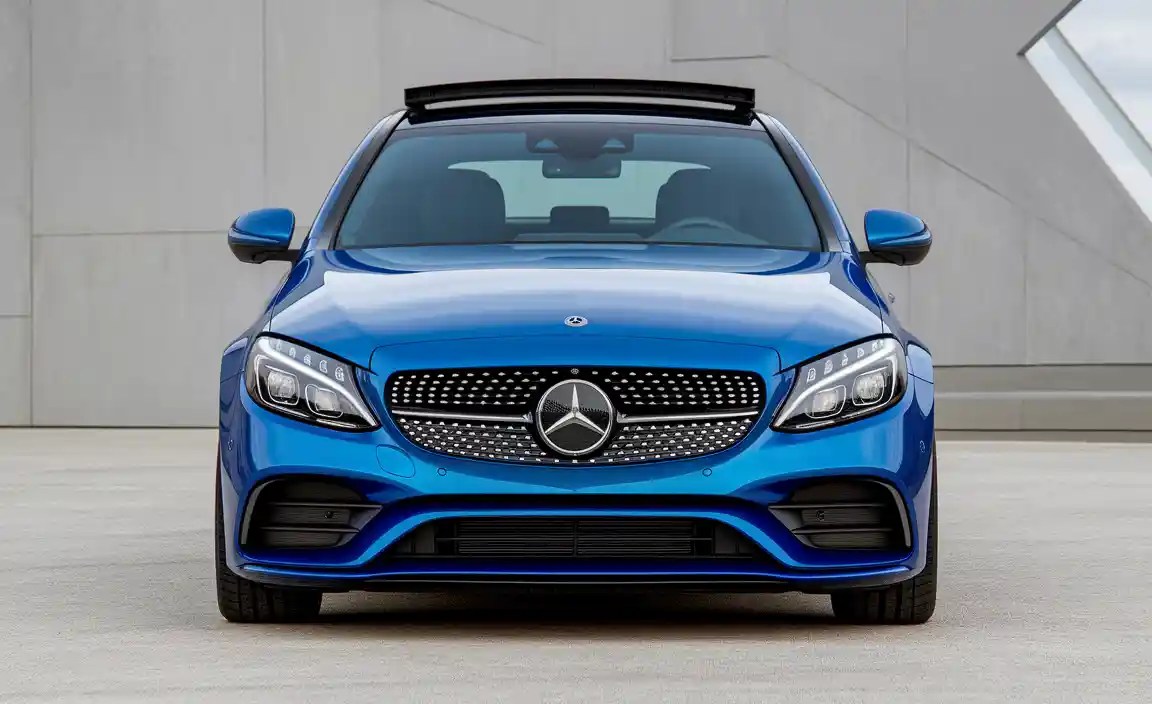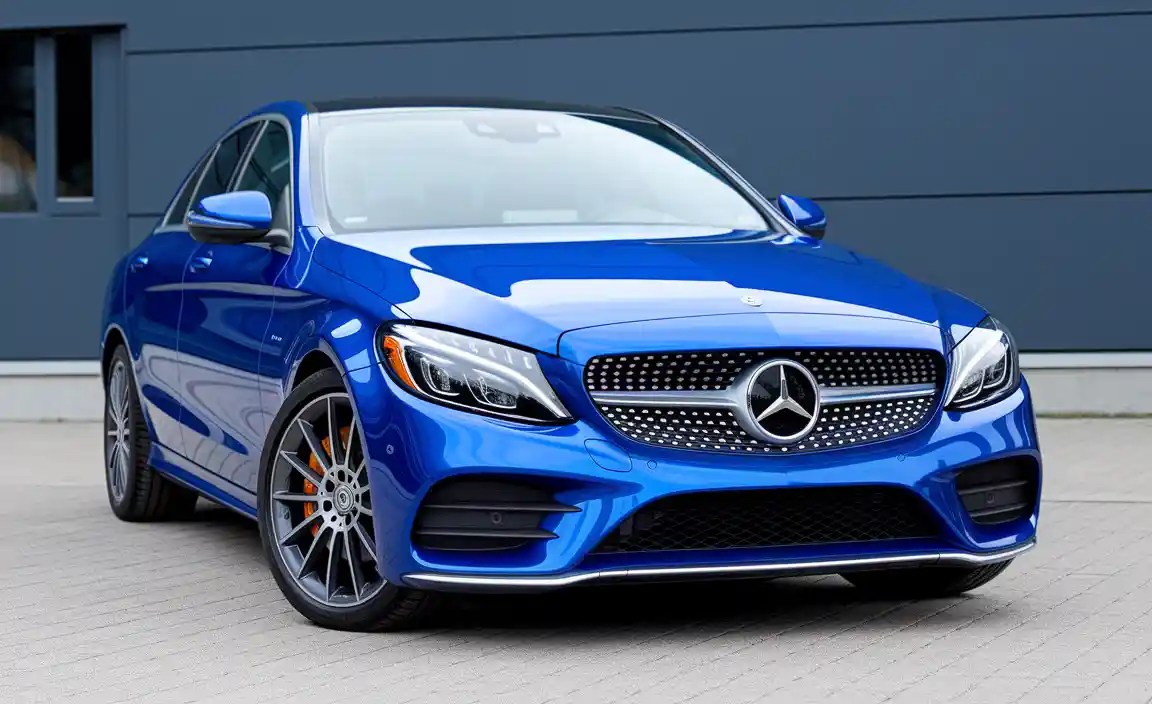Mercedes-Benz C Class Battery Replacement Cost: Effortless Power
Your Mercedes-Benz C-Class battery replacement cost typically ranges from $250 to $800, depending on the battery type, model year, and whether you choose a dealership or an independent mechanic. This guide breaks down pricing to help you budget and maintain effortless power.
Keeping your Mercedes-Benz C-Class running smoothly means paying attention to its vital components, and the battery is at the heart of it all. When it starts to fade, you might notice dimming lights, slow cranking, or even electrical gremlins. Replacing a C-Class battery doesn’t have to be a source of stress or surprise.
This guide will demystify the process and the costs involved, ensuring you can keep your luxury sedan powered up and ready for the road ahead. We’ll walk through what influences the price, offer cost estimates, and explain how to get the best value for your money.

Understanding Battery Types for Your C-Class
Mercedes-Benz C-Class vehicles, depending on their model year and specific features, utilize different types of batteries to power their sophisticated electrical systems. The two primary types you’ll encounter are traditional Flooded Lead-Acid (FLA) batteries and the more advanced Absorbent Glass Mat (AGM) batteries.
FLA batteries are the standard in many older vehicles. They contain liquid sulfuric acid and require occasional maintenance, such as checking water levels. While more affordable upfront, they are generally less resilient to deep discharges and vibrations compared to AGM batteries.

AGM batteries, on the other hand, are the standard for most modern C-Class models, especially those equipped with start-stop technology or extensive electronic features. In an AGM battery, the electrolyte is absorbed into glass mats that separate the lead plates. This design offers several advantages:
- Enhanced Durability: They are more resistant to vibrations and shocks, which is crucial for a vehicle that experiences varied road conditions.
- Spill-Proof Design: Being sealed, they are spill-proof and can be mounted in various positions, offering greater flexibility in vehicle design.
- Better Performance: AGM batteries provide higher cranking power and can handle deep discharges and rapid recharging cycles more effectively, making them ideal for vehicles with frequent engine start-stop cycles.
- Longer Lifespan: Typically, AGM batteries last longer than traditional FLA batteries when properly maintained.
The type of battery your C-Class requires is often dictated by its original specifications. Using the wrong type can lead to performance issues or damage to your vehicle’s electrical system. Always consult your owner’s manual or a reputable mechanic to confirm the correct battery type for your specific C-Class model year.
Factors Influencing C-Class Battery Replacement Cost
The price tag for replacing your C-Class battery isn’t a one-size-fits-all number. Several key factors contribute to the overall cost, and understanding these will help you anticipate expenses and make informed decisions.
Battery Type and Brand
As discussed, AGM batteries are more advanced and thus typically cost more than traditional lead-acid batteries. Furthermore, premium brands known for their quality and reliability will command higher prices than generic or less established brands. Mercedes-Benz genuine parts, while offering a perfect fit and proven performance, often come at a premium compared to high-quality aftermarket options.
Model Year and Specific C-Class Model
Different generations and specific models within the C-Class lineup might use batteries with varying specifications (size, amperage, terminal placement) and may require different installation procedures. For instance, newer C-Class models with advanced technology packages might require specialized AGM batteries that are pricier. The complexity of accessing the battery location can also play a role in labor costs.
Labor Costs: Dealership vs. Independent Shop
The biggest variable in the “effortless power” equation is labor. Dealerships, while offering genuine OEM parts and specialized knowledge of Mercedes-Benz vehicles, generally have higher hourly labor rates. Independent European auto specialists may offer more competitive pricing for labor. A DIY replacement, of course, eliminates labor costs entirely, but requires the right tools and knowledge.
Geographic Location
Labor rates and parts pricing can fluctuate significantly based on your geographic location. Major metropolitan areas typically have higher costs for both parts and labor compared to smaller towns or rural areas.
Additional Services
Sometimes, a battery replacement might uncover other issues, or you might opt for additional services like battery terminal cleaning or corrosion treatment. These can add to the final bill.
Typical C-Class Battery Replacement Cost Breakdown
To give you a clearer picture, here’s an estimated breakdown of what you might expect to pay for a C-Class battery replacement. These figures are averages and can vary widely.

Battery Cost Range
The battery itself for a Mercedes-Benz C-Class can range anywhere from $150 to $450. This depends heavily on whether you’re opting for a lower-end aftermarket option, a reputable aftermarket brand, or a genuine Mercedes-Benz part. AGM batteries, which are common in newer C-Class models, fall on the higher end of this spectrum.
Labor Cost Range
Labor costs can vary significantly. At a Mercedes-Benz dealership, you might expect to pay anywhere from $100 to $350 for the installation, reflecting their specialized overhead and labor rates. An independent European auto shop could charge between $75 to $200 for labor. The complexity of reaching the battery in your specific C-Class model year is a major factor here.
Total Estimated Cost
Combining the battery and labor costs, a C-Class battery replacement typically falls within the range of $250 to $800.
Here’s a table to summarize the average costs:
| Service Component | Estimated Cost Range (USD) | Notes |
|---|---|---|
| Aftermarket Battery (FLA/AGM) | $150 – $300 | Quality varies by brand. |
| Premium Aftermarket Battery (AGM) | $250 – $400 | Reputable brands offering good warranties. |
| Genuine Mercedes-Benz Battery (AGM) | $300 – $450+ | OEM quality, perfect fit, often with a good warranty. |
| Labor (Independent Shop) | $75 – $200 | Depends on shop rates and battery location. |
| Labor (Mercedes-Benz Dealership) | $100 – $350 | Higher rates but specialized knowledge. |
| Total Estimated Cost (DIY Friendly) | $225 – $700 | Purchasing battery separately, performing DIY installation. |
| Total Estimated Cost (Shop Installed) | $250 – $800+ | Includes battery and professional installation. |
How Long Does a C-Class Battery Last?
The lifespan of your Mercedes-Benz C-Class battery is influenced by several factors, including the type of battery, climate, driving habits, and maintenance. On average, you can expect a car battery to last between 3 to 5 years.
Several elements can shorten or extend this lifespan:
- Climate: Extreme temperatures, both hot and cold, can significantly impact battery performance and longevity. Heat, in particular, accelerates the chemical reactions inside the battery, leading to faster degradation.
- Driving Habits: Frequent short trips where the battery doesn’t have enough time to fully recharge can reduce its lifespan. Conversely, consistent long drives help keep the battery at optimal charge.
- Electrical Load: Heavy use of accessories (infotainment systems, heated seats, lights) while the engine is off can drain the battery and put extra strain on it.
- Maintenance: Keeping battery terminals clean and ensuring the battery is securely mounted can prevent issues that might shorten its life. For older FLA batteries, maintaining water levels is crucial.
- Battery Type: As mentioned, AGM batteries generally offer a longer service life than traditional lead-acid batteries, especially in vehicles with start-stop systems.
Paying attention to the signs of a weakening battery can help you replace it before it leaves you stranded. This proactive approach ensures your C-Class continues to deliver its signature effortless power.
Signs Your C-Class Battery Needs Replacing
Recognizing the early indicators of a failing battery is key to avoiding roadside assistance calls and unexpected disruptions. Your C-Class will often give you subtle clues that its power source is weakening.
Here are common signs to look out for:
- Slow Engine Crank: When you turn the key or press the start button, if the engine cranks over slower than usual, it’s a strong sign the battery is struggling to provide enough power.
- Dimming Lights: Headlights, interior lights, or dashboard lights that appear dimmer than normal, especially when the engine is off or at idle, indicate a weak electrical supply from the battery.
- Electrical Issues: You may notice other electrical components acting erratically. This could include power windows operating slowly, the infotainment system glitching, or warning lights appearing on the dashboard that don’t have a clear cause.
- Battery Warning Light: Modern vehicles have sophisticated warning systems. If the battery or check engine light illuminates on your dashboard, it’s crucial to have the system checked.
- Swollen or Leaking Battery Case: If you can visually inspect the battery (often located under the hood or in the trunk/fender well depending on the model), a swollen or cracked case is a clear sign of internal damage and imminent failure. This can also lead to corrosion around the terminals.
- Age of the Battery: If your battery is over three years old and you start experiencing any of the above symptoms, it’s wise to have it tested. Batteries don’t last forever, and age is a significant factor in their reliability.
When in doubt, a professional battery test can definitively indicate the health of your C-Class battery. Most auto parts stores and repair shops offer this service, often for free.
The DIY Battery Replacement Process for Your C-Class
Replacing the battery on your Mercedes-Benz C-Class yourself can be a rewarding way to save on labor costs. While the exact steps can vary slightly by model year, the general process is manageable for those with basic automotive knowledge and the right tools.

Tools and Materials You’ll Need
- New Battery: Ensure it’s the correct type, size, and Cold Cranking Amps (CCA) for your specific C-Class. Check your owner’s manual or online resources for compatibility.
- Socket Set/Wrenches: Typically, you’ll need a 10mm, 13mm, or similar sized socket or wrench for terminal clamps and battery hold-downs.
- Anti-Corrosion Spray or Grease: For cleaning and protecting terminals.
- Battery Terminal Cleaner Tool: A wire brush or specialized tool to clean corrosion from terminals and clamps.
- Gloves and Safety Glasses: To protect yourself from battery acid and debris.
- Memory Saver (Optional but Recommended): A device that plugs into the OBD-II port or cigarette lighter to maintain power to vehicle electronics while the battery is disconnected. This preserves radio presets, clock settings, and other computer memory. You can learn more about memory savers and their importance at AutoZone’s guide.
- Torque Wrench (Optional): For ensuring terminals and hold-downs are tightened to specification.
Step-by-Step Replacement Guide
- Locate the Battery: Consult your C-Class owner’s manual to find the battery’s location. In many models, it’s under the hood. In others, it might be in the trunk or under a fender well, requiring more involved disassembly.
- Disconnect the Negative Terminal First: This is a critical safety step. Use your wrench to loosen the nut on the negative (-) terminal clamp. Once loose, twist and pull the cable off the terminal. Tuck it away so it cannot accidentally touch the terminal.
- Disconnect the Positive Terminal: Loosen and remove the positive (+) terminal clamp. Tuck it away similarly.
- Remove the Battery Hold-Down: Batteries are secured by a bracket or clamp at the base or top. Unbolt and remove this to free the battery.
- Lift Out the Old Battery: Batteries are heavy! Use a proper lifting strap if available, or carefully grip the battery to lift it straight out of its tray. Be mindful of your back.
- Clean the Battery Tray and Terminals: Use a wire brush or terminal cleaner to remove any corrosion or debris from the battery tray and both the positive and negative terminal clamps. Apply anti-corrosion spray or grease.
- Install the New Battery: Carefully lower the new battery into the tray, ensuring it is seated correctly.
- Secure the Battery Hold-Down: Reinstall the hold-down bracket and tighten it to secure the battery firmly.
- Connect the Positive Terminal First: Place the positive (+) terminal clamp onto the battery post and tighten it securely.
- Connect the Negative Terminal: Place the negative (-) terminal clamp onto the battery post and tighten it securely.
- Double-Check Connections: Ensure both terminals are tight and the battery is stable.
- Start the Vehicle: Turn the ignition to start your C-Class. The engine should start without issue. You may need to reset your radio presets or clock if you didn’t use a memory saver.
Important Note on Battery Registration: For some modern Mercedes-Benz vehicles, especially those with IBS (Intelligent Battery Sensor) systems, the new battery may need to be “registered” with the vehicle’s computer system. This tells the car it has a new battery, often allowing it to adjust charging parameters. Failure to register can sometimes lead to premature battery failure or charging issues. This registration process often requires specialized diagnostic tools, which is why many owners opt for professional installation for newer models.
When to Call a Professional
While DIY is an option, there are certain situations where calling a professional for your C-Class battery replacement is the smarter, safer choice:
- Complex Battery Location: If your C-Class battery is located in a difficult-to-reach spot like the trunk, beneath a wheel well liner, or requires significant disassembly of interior panels or engine components, professional expertise can save you time and prevent accidental damage.
- Lack of Tools or Confidence: If you don’t have the necessary tools, are unsure about the process, or simply don’t feel confident performing the job, a professional mechanic has you covered.
- Battery Registration Required: As mentioned, newer Mercedes-Benz models often require battery registration by a mechanic with the proper diagnostic equipment. If your model year necessitates this, professional installation is essential.
- Persistent Electrical Issues: If your C-Class has been experiencing ongoing electrical problems, a simple battery replacement might not fix the root cause. A professional can diagnose the entire electrical system.
- Warranty Concerns: If your vehicle is still under warranty, attempting a DIY repair could potentially void certain aspects of it. Check your warranty terms.
- Heavy Corrosion or Damage: If you find significant corrosion on battery terminals, cables, or the battery tray, or if there’s visible damage to the battery itself, it’s best to let a professional handle the removal and cleanup safely.
For these reasons, many owners find peace of mind in entrusting their C-Class battery replacement to a qualified technician, ensuring the job is done correctly and safely.
Choosing the Right Battery for Your C-Class

Selecting the correct battery is paramount for the optimal performance and longevity of your Mercedes-Benz C-Class. It’s not just about fitting it in the tray; it’






